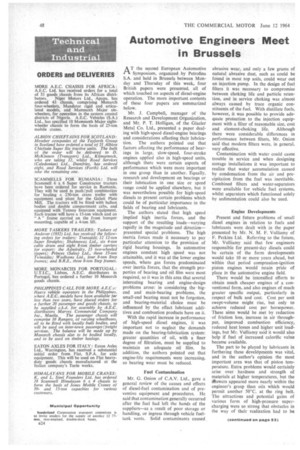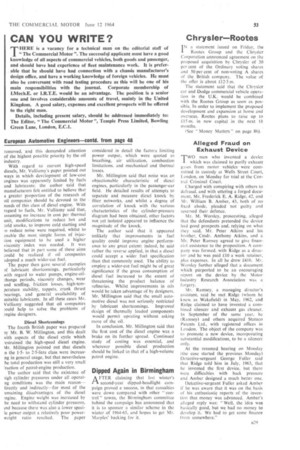Automotive Engineers Meet in Brussels
Page 50

Page 55

If you've noticed an error in this article please click here to report it so we can fix it.
AT the second European Automotive Symposium, organized by Petrofina S.A. and held in Brussels between Monday and Thursday of this week, four British papers were presented, all of which touched on aspects of diesel-engine operation. The more important contents of these four papers are summarized below.
Mr. J. Campbell, manager of • the Research and Development Organization, and Mr. P. T. Holligan, of the Glacier Metal Co. Ltd., presented a paper dealing with high-speed diesel-engine bearings and considerations affecting their lubrication. The authors pointed out that factors affecting the performance of bearings in large, slow-speed, four-stroke engines applied also in high-speed units, although there were certain aspects of performance which were more important in one group than in another. Equally, research and development on bearings or their lubrication in one size or speed range could be applied elsewhere, but it was nevertheless possible for high-speed diesels to present certain problems which could be of particular importance in the fields of bearing and lubricants.
The authors stated that high speed implied high inertia forces, and the support of the resulting loads—varying rapidly in the magnitude and direction— presented special problems. The high inertia forces made it necessary to pay particular attention to the provision of rigid bearing housings. In automotive engines constant high speed was not attainable, and it was at the lower engine speeds, where gas forces predominated over inertia forces, that the strength properties of bearing and oil film were most required, so it was in this area that several interesting bearing and engine-design problems arose: in considering the big end and main-bearing problems, the small-end bearing must not be forgotten, and bearing-material choice must be influenced by the effect lubricant additives and combustion products have on it.
With the rapid increase in performance of high-speed diesel engines, it was important not to neglect the demands made on the bearing-lubrication system: greater quantities of oil, with a finer degree of filtration, must be supplied to maintain an adequate oil film. In addition, the authors pointed out that engine-life requirements were increasing, so bearing wear must be reduced.
Fuel Contamination
Mr. G. Onion of C.A.V. Ltd., gave a general review of the causes and effects of diesel-fuel contamination and of preventive equipment and procedures. He said that contamination generally occurred after the fuel had left the hands of the suppliers—as a result of poor storage or handling, or ingress through vehicle fueltank vents. Solid contaminants caused abrasive wear, and only a few grams of natural abrasive dust, such as could be found in most top soils, could wear out an injection pump. In the design of fuel filters it was necessary to compromise between choking life and particle retention, and in service choking was almost always caused by trace organic constituents of the fuel. With distillate fuels, however, it was possible to provide adequate protection to the injection equipment with a filter of reasonable size, cost and element-choking life. Although there were considerable differences in performance between filters, Mr. Onion said that modern filters were, in general, very effective.
Contamination with water could cause trouble in service and when designing storage installations it was important to realize that water accumulation caused by condensation from the air and precipitation from the fuel was inevitable. Combined filters and water-separators were available for vehicle fuel systems, whilst separators which functioned solely by sedimentation could also be used.
Engine Developments
Present and future problems of small diesel engines in relation to fuels and lubricants were dealt with in the paper presented by Mr. N. M. F. Vulliamy of F. Perkins Ltd. Referring to the future, Mr. Vulliamy said that few engineers responsible for present-day diesels could be certain of the form developments would take 10 or more years ahead, but within that period compression-ignition piston engines would retain pride of place in the automotive engine field.
There would be intensified efforts to obtain much cheaper engines of a conventional form, and also engines of much greater specific output, particularly in respect of bulk and cost. Cost per unit swept-volume might rise, but only to achieve reduced cost per horsepower. These aims would be met by reduction of friction loss, increase in air throughput, improved combustion efficiency, reduced heat losses and higher unit loadings, but Mr. Vulliamy said it would also help if fuel of increased calorific value became available.
The part to be played by lubricants in furthering these developments was vital, and in the author's opinion the most important area was that of piston temperature. Extra problems would certainly arise over hardness and strength of materials at higher temperatures, but the dtiswers appeared more nearly within the engineer's grasp than oils which wouldpermit another 50°C. at the ring belt. The attractions and potential gains of various form of high-pressure supercharging were so strong that obstacles in the way of their realization had to be
removed, and this demanded attention of the highest possible priority by the oil industry.
With regard to current high-speed diesels, Mr. Vulliamy's paper pointed out ways in which development of low-cost engines was apparently limited by fuels and lubricants: the author said that manufacturers felt entitled to believe that a greater proportion of the research of oil companies should be devoted to the needs of this class of diesel engine. With regard to fuels, Mr. Vulliarny said that, assuming no increase in cost per thermal unit, modifications to reduce hot and :old smoke, to improve cold starting and [0 reduce noise were required, whilst to enable the most simple forms of injection equipment to he used a higher viscosity index was needed. It was believed that in part some of these aims could be realized if oil companies adopted a much wider-cut fuel.
The paper then gave several examples nf lubricant shortcomings, particularly with regard to water pumps, engine-oil:flange periods, viscosity changes, wear and scuffing, friction losses, high-temperature stability, tappets, crank thrust bearings, and general availability .of suitable lubricants. In all these cases Mr. Vulliamy suggested that oil companies :ould help to solve the problems of nigine designers.
Diesel Shortcomings
The fourth.British paper was prepared b.y. Mr. B. W. Millington, and this dealt vith aspects of the diesel cycle which. restrained the high-speed diesel engine. Mr. Millington pointed out that diesels n the 1-5to 2-5-litre class were increasng in general usage, but that nevertheless he total production was still a very small 'raction of petrol-engine production.
The author said that the existence of tigh cylinder pressures under all operatng conditions was the main reasonlireetly and indirectly—for most of the .emaining disadvantages of the diesel mgine. Engine weight was increased by he need to withstand cylinder pressures, Ind because there was also a lower speciic power output a relatively poor powerweight ratio resulted. The paper considered in detail the factors limiting power output, which were quoted as breathing, air utilization, combustion limitations, and mechanical and thermal losses.
Mr. Millington said that noise was an objectionable characteristic of diesel engines, particularly in the passenger-car field. He detailed results of attempts to separate and measure diesel knock by filter networks, and whilst a degree of correlation of knock with the various characteristics of the cylinder-pressure diagram had been obtained, other factors not yet isolated appeared to influence the magnitude of the knock.
The author said that it appeared unlikely that improvements in fuel quality could improve engine performance to any great extent: indeed, he said rather the reverse applied, in that a diesel could accept a wider fuel specification than that commonly used. The ability to employ a wider-cut fuel might be of great significance if the gross consumption of diesel fuel increased to the extent of threatening the product balance of refineries. Whilst improvements in oils would be taken advantage of by designers, Mr. Millington said that the small automotive diesel was not seriously restricted by lubricant shortcomings. Improved design of thermally loaded components would permit uprating without asking more of the oil.
In conclusion, Mr. Millington said that the first cost of the diesel engine was a brake on its further spread. Continued study of costing was essential, and wherever possible diesel production should be linked to that of a high-volume petrol engine.
































































































































